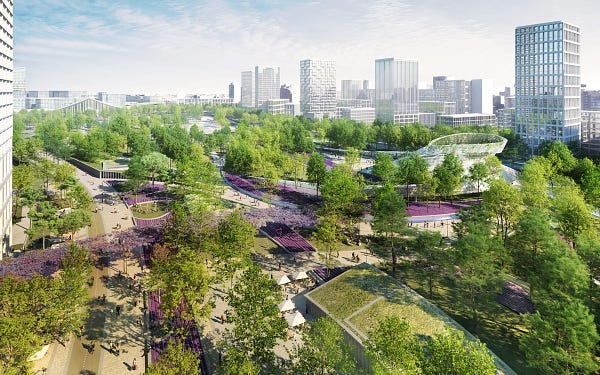Urbanism Wins Through Exposing False Choices
It's one thing to tell the truth. It's another to show it.
As the NFL postseason has played out over the last few weeks, the teams that have managed to advance tend to have one thing in common: they find the thing their opponent does best on offense and build their entire defensive game plan to take that one thing away. Force the other team to beat them with something else.
And we see this beyond the world of sports. In politics, candidates focus most of their preparation on talking points and counterarguments aimed at their opponent’s most prominent policy positions. In business, you find the one thing that sets your brand or offering apart, making the best features, pricing, etc. of the competition irrelevant.
Taking away your opponent’s best offensive weapon happens everywhere.
Including urbanism.
So what is the primary weapon of urbanism’s opponents?
False choices.
Consider some of the things that are pitted against each other by those that resist more walkable, dense, human-centered places:
New housing or community stability
Transportation freedom or transportation access
Density or green space
We see it all the time.
So what do we do about it? How do you take it away?
It’s one thing to know your own playbook. But urbanist talking points and statistics only go so far. Shutting down false narratives requires telling a better and truer story.
Storytelling is done in two key ways:
1. Connect Ideas to Images
Cliches often exist because they’re true: a picture can be worth a thousand words.
The simple addition of a visual to show what’s possible can go a long way, especially for those who’ve never actively engaged their imaginations with what better cities can look like.
Whether on social media (see above), through other content, or in personal conversations (texting, email, etc.), incorporate images whenever possible. Consider building a swipe file of images that best-showcase the ideas you’re looking to convey so you’re not scrambling through Google Images when a conversation arises.
The fire of imagination often requires some kindling to get started, so having some “fire starters” handy will make you a far more effective communicator. When people can see the truth, they also see false choices for what they really are.
2. Bring Images to Life
Images can woo skeptics and provide an onramp to urbanist ideals. They show what’s possible. But images alone can’t prove what’s “doable.”
Without signs of life in someone’s own local built environment, it becomes easy to buy back into the idea that “you can’t have it all.” Because surely there’s a reason it hasn’t happened yet, right?
That’s why dismantling false choice narratives requires embracing an incremental approach; a something is better than nothing mindset.


When we apply perfectionism and urbanism snobbery to imperfect progress, we not only demote ourselves to mere virtual signalers; we demonstrate that we lack the contextualization skills to effectively move the ball down the field in our own backyards.
Ski patrols know that it doesn’t take much to start an avalanche. But if you didn’t know better, you’d look at the initial bits of snow and ice tumbling down the mountain and think “that’s not going to do anything.”
So often, we do that with the very projects that can begin to turn the tides in our communities rather than throwing our support behind those projects. In doing so, we send the message to our neighbors that “it can’t happen here.” And the false choice narratives persist.
-
While you’ll never win everyone, the “imagine and experience” playbook is how you play the game with integrity. It plants a flag.
It shows that we believe so much in the power of human-centered places that exposing people to them through images and first-person interaction is the most compelling sell we have.
Because ultimately, they sell themselves.




Storytelling for the win. Too many urbanists think it's icky, but it is The Way!